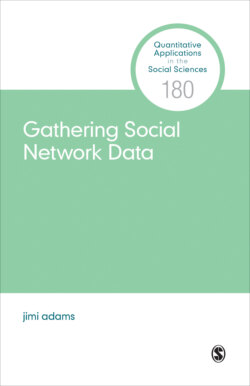Читать книгу Gathering Social Network Data - jimi adams - Страница 7
Series Editor’s Introduction
ОглавлениеIt is with great pleasure that I introduce Gathering Social Network Data, by jimi adams. This new volume fills a gap in the QASS series as well as in the literature more generally. There are several excellent texts describing social network analysis, including the one by David Knoke and Song Yang (No. 154) in this series. However, there is no text discussing methods for designing, collecting, and evaluating the data that are the subject of these analytic techniques. Such a text is urgently needed given the impressive growth in social networks research.
An expert on social networks, adams drew on his extensive experience teaching these methods to design a QASS volume that appeals to readers at all levels. For novices, adams introduces topics in a time-tested and systematic way, is careful to define terms (both in the text and in a glossary), and illustrates his points with lots of examples. The volume could serve as a useful supplement in an advanced undergraduate course or graduate seminar. For experts, he explores technicalities and points to current debates in the literature through extensive footnoting. Researchers already well established in the field will also benefit from its cogent discussion of issues surrounding the design, collection, and assessment of social network data.
As adams explains in the preface, the volume focuses on principles, with the goal of providing readers the tools needed to develop their own approach to gathering social network data. Chapter 1 introduces basic concepts, describes theoretical perspectives, and reviews types of ties and the kinds of questions of interest in social research. Chapter 2 focuses on three considerations that must be addressed in any network study: tie measurement (name generators, name interpreters, resource generators), sampling design (ego based, complete, and partial network designs), and inclusion and exclusion criteria (i.e., boundary specification). The ordering of the topics in this chapter is reflective of adams’s own teaching strategy and what has worked best over years of experience. Chapter 3 addresses modes of social network data collection, distinguishing between active and passive approaches. Chapters 1 through 3 are the core of the volume.
Chapters 4 through 6 take up critical topics that need to be considered when gathering social network data. Ethical issues are the subject of Chapter 4. Generally speaking, these issues are the same as with any social research—voluntary participation, consent, and minimization of risks—but there are some peculiarities to social network data, especially the important role of “alters” (are they human subjects?) and heightened risks of deductive disclosure (based on potentially recognizable patterns of connection). Chapter 5 provides a valuable discussion of data quality, including what has been reported about the strengths and weaknesses of social network data in the research literature. Missing data may arise for a variety of reasons, for example, each of which has different implications for inferences analysts might wish to draw. Chapter 6 points the way forward, identifying fruitful topics that are likely to be the subject of additional exploration in the coming years.
Gathering Social Network Data is beautifully organized and written. The text is engaging: The voice of the author is present on every page. The volume is replete with examples that illustrate the various choices that researchers must make in designing social network data. Reviewers were very pleased to see sample instruments in the appendices. This was a first—to have appendices singled out for praise! Whether you are new to the field or an experienced practitioner, you will appreciate this volume.
—Barbara Entwisle
Series Editor
